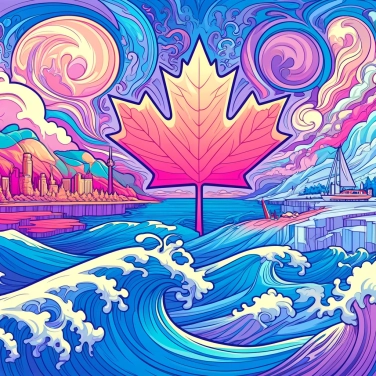The Great Lakes are important for Canada because they provide essential fresh water to the population, agriculture, and industry. They also play a crucial role in inland navigation and tourism in the region.

The Great Lakes represent about 20% of the world's surface freshwater reserves. Not bad, right? On the Canadian side, this simply means a crucial source of drinking water for millions of Canadians. With a growing population around the lakes, they daily meet the essential water needs of households, cities, and local industries. But be careful, preserving their quality is essential: pollution or waste would be truly problematic in the long term, which is why Canada places great importance on these precious resources.
The Great Lakes are an essential network for maritime transport in North America. Thanks to the Saint Lawrence River and artificial canals, such as the Saint Lawrence Seaway, Canada enjoys direct and easy access to the Atlantic Ocean. Every year, these maritime routes allow for the transport of several million tons of raw materials such as iron ore, coal, wheat, and steel. For Canada, it is a cost-effective and reliable means of transporting heavy goods over long distances, thus promoting international trade with the United States and other countries. Without these arteries, logistical costs would skyrocket, and the economy would clearly suffer the consequences.
Every year, the Great Lakes attract millions of tourists who come to explore their vast beaches, engage in fun water activities like kayaking or sailing, or simply admire breathtaking landscapes. Tourists also flock to cities like Toronto or Kingston, which greatly benefit from the unmatched charm of the shores of Lake Ontario. Culturally, it is rich as well: local festivals, regional cuisine (fresh fish, Canadian specialties), and especially significant historical landmarks, with sites related to Indigenous peoples or spectacular shipwrecks attracting divers and the curious. These activities represent a substantial source of income for local economies, supported by a real tourist industry all around the lakes.
The Great Lakes represent one of the most diverse and dynamic ecosystems in Canada. They are home to thousands of species, such as the yellow perch, the northern pike, and the chinook salmon. These lakes also host various species of migratory birds and provide essential habitats for rare reptiles and amphibians, such as the spotted turtle. The richness of this biodiversity is not just a beautiful postcard; it balances ecosystems, ensures the natural quality of water, and provides food and resources for local populations. This natural dynamism attracts researchers, scientists, and nature enthusiasts from around the world.
This region is a true economic engine for Canada. The Great Lakes host powerful industries such as automotive, steelmaking, aerospace, and hydroelectric power generation. Around these giant bodies of water, cities like Toronto, Hamilton, and Windsor have seen factories and jobs grow, attracting a strong workforce. The proximity to ports, waterways, and the American market facilitates import-export and allows these regions to remain highly competitive. Not to mention that these industries generate enormous spillover effects, making this area one of the essential economic hubs of the country.
Nearly 30% of the Canadian population lives in the Great Lakes watershed, which serves as both a major economic driver and a significant source of drinking water.
The Great Lakes constitute the largest group of freshwater lakes in the world by surface area, covering nearly 245,000 square kilometers. That's almost the size of the United Kingdom!
Lake Superior is the largest of the Great Lakes and contains more fresh water than all the other Great Lakes combined, accounting for nearly 10% of the planet's surface fresh water.
There are over 3,500 plant and animal species in the Great Lakes ecosystem, some of which are unique to the world and very sensitive to environmental changes.
The main goods transported on the Great Lakes include ores (iron), grains, coal, cement, and steel. This network is an essential component of domestic and international trade for Canada, facilitating the transport of heavy and bulky goods.
Among the major tourist sites are the famous Niagara Falls (Lake Ontario and Lake Erie), the Bruce Peninsula National Park (Lake Huron), the picturesque coastlines of Bruce Peninsula National Park, the Thousand Islands Parkway (Lake Ontario), and the beaches of Sandbanks Provincial Park (Lake Ontario). These regions attract millions of visitors each year.
The five Great Lakes are Lake Superior, Lake Michigan, Lake Huron, Lake Erie, and Lake Ontario. Among these five, only Lake Michigan does not directly touch Canada; the other four share shores and borders with Canadian territory.
The main environmental challenges of the Great Lakes include water pollution (heavy metals, microplastics, agricultural chemicals), invasive aquatic species (such as zebra mussels and Asian carp), loss of coastal habitat, eutrophication (harmful algal blooms), and issues related to climate change.
The Great Lakes have a significant influence on the regional climate. Due to their large volume of freshwater, they act as climate moderators, reducing extreme temperatures. In winter, for example, they limit the rapid cooling of the air and generate localized snowstorms, known as "lake effects," in the neighboring areas.

No one has answered this quiz yet, be the first!' :-)
Question 1/5